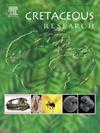Foraminifera and ostracod biostratigraphy of the English Coniacian – Campanian (Upper Cretaceous) Chalk: New results from Seaford Head and correlation to Eastern Europe
IF 1.7
3区 地球科学
Q1 GEOLOGY
引用次数: 0
Abstract
The uppermost Turonian – lower Campanian Chalk succession at Seaford Head, southern England, is described and the placement of stage and substage boundaries are defined. Previous studies of foraminifera and ostracods in the section are reviewed. New data are provided for 99 samples spanning the full exposed section. Samples yielded abundant well-preserved diverse microfossil assemblages. The stratigraphic distributions of 38 selected stratigraphically important foraminifera species of Gavelinella, Stensioeina, Protostensioeina, Bolivina, Bolivinoides, Pyramidina, Pseudouvigerina and planktonic foraminifera (Contusotruncana, Globotruncana, Marginotruncana), and 40 ostracod taxa are presented. A list of taxa with taxonomic notes and descriptions of five new foraminifera species, Gavelinella praestelligera, G. praethalmanni, G. praetumida, Protostensioeina ukrainica and Stensioeina praeexsculpta, and three informal species, Pyramidina sp. A, B and C is included. Evolutionary lineages of foraminifera genera provide the basis for a refined biostratigraphy that is successfully correlated to Salzgitter-Salder, Germany and Dubivtsi, Ukraine. Records are compared to literature data and benthic foraminifera zonations across northern Europe. However, differing taxonomic concepts of authors hamper comparison with literature data, exemplified by critical review of previous work at Seaford Head. This precludes rigorous assessment of diachronism of marker species, although regional stratigraphic differences in the distribution of the first stensioeinids and representatives of the Gavelinella clementiana group in Europe are apparent. The first detailed ostracod records from the English Coniacian – Campanian are presented. Four new ostracod biozones defined by the lowest occurrences of the index taxa are proposed: Neocythere (Physocythere) virginea; Limburgina senonensis; Phacorhabdotus lonsdaleianus; and Pterygocythere laticristata zones.
英国Coniacian - Campanian(上白垩世)白垩系有孔虫和介形虫生物地层:来自seford Head的新结果和与东欧的对比
描述了英国南部Seaford Head的上Turonian -下Campanian白垩系序列,并确定了阶段和次阶段边界的位置。本文对该段有孔虫类和介形虫类的研究进行了综述。提供了99个样本的新数据,覆盖了整个暴露剖面。样品产生了大量保存完好的各种微化石组合。本文介绍了38种具有重要地层意义的有孔虫(Gavelinella, Stensioeina, Protostensioeina, Bolivina, Bolivinoides, Pyramidina, Pseudouvigerina)和浮游有孔虫(Contusotruncana, Globotruncana, Marginotruncana)以及40个介形虫类群的地层分布。本文收录了有孔虫新种(Gavelinella praestelligera、g.p aeethalmanni、g.p praetumida、Protostensioeina ukrainica和praeexsculpta)和非正式种(Pyramidina sp. A、B和C),并附有分类注释和描述。有孔虫属的进化谱系为精细的生物地层学提供了基础,成功地将其与德国萨尔茨吉特-萨尔德和乌克兰杜比夫茨相关联。将记录与文献数据和北欧底栖有孔虫带进行比较。然而,作者的不同分类概念阻碍了与文献数据的比较,例如对以前在西福德海德工作的批判性审查。这就排除了对标志物种的历时性的严格评估,尽管在欧洲,第一批张氏纲和Gavelinella clementana群的代表在分布上的区域地层差异是明显的。本文首次详细记录了英国康涅西亚-坎帕尼亚的介形类。本文提出了四个新的介形类生物带:Neocythere (physicythere) virginea;Limburgina senonensis;Phacorhabdotus lonsdaleianus;和翼状细胞的乳化带。
本文章由计算机程序翻译,如有差异,请以英文原文为准。
求助全文
约1分钟内获得全文
求助全文
来源期刊

Cretaceous Research
地学-地质学
CiteScore
4.10
自引率
19.00%
发文量
235
审稿时长
12 weeks
期刊介绍:
Cretaceous Research provides a forum for the rapid publication of research on all aspects of the Cretaceous Period, including its boundaries with the Jurassic and Palaeogene. Authoritative papers reporting detailed investigations of Cretaceous stratigraphy and palaeontology, studies of regional geology, and reviews of recently published books are complemented by short communications of significant new findings.
Papers submitted to Cretaceous Research should place the research in a broad context, with emphasis placed towards our better understanding of the Cretaceous, that are therefore of interest to the diverse, international readership of the journal. Full length papers that focus solely on a local theme or area will not be accepted for publication; authors of short communications are encouraged to discuss how their findings are of relevance to the Cretaceous on a broad scale.
Research Areas include:
• Regional geology
• Stratigraphy and palaeontology
• Palaeobiology
• Palaeobiogeography
• Palaeoceanography
• Palaeoclimatology
• Evolutionary Palaeoecology
• Geochronology
• Global events.
 求助内容:
求助内容: 应助结果提醒方式:
应助结果提醒方式:


